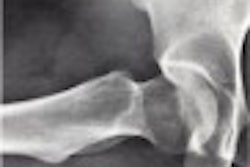German researchers recently conducted an observer preference study comparing flat-panel digital radiography to computed radiography and film-screen chest radiography. They found that DR was as good as, or better than, the other technologies for visualizing anatomic structures. And they concluded that DR's high performance could be achieved with a reduced radiation dose.
Drs. Marika Ganten, Boris Radeleff, Annette Kampschulte, Mark Daniels, Günter Kauffmann, and Jochen Hansmann, from Radiological University Hospital at Ruprecht-Karls-University in Heidelberg, Germany, compared chest x-rays taken with film-screen, CR, and DR systems on the same 30 patients (average age 63.5 years), who had undergone abdominal surgery during a seven-month period. All imaging procedures were conducted from10 days to three months post-surgery.
"Patient examinations were performed under identical exposure conditions (automatic exposure control using the same peak kilovoltage, tube current, and grid) with the exception of a reduction of 50% for the patient radiation dose in the flat-panel images," the authors wrote (American Journal of Roentgenology, July 2003, Vol. 181:1, pp. 171-176).
Technologies
The group used a dedicated automatic film-screen chest system (Thoramat, Siemens Medical Solutions, Erlangen, Germany) as a standard reference, along with a standard x-ray tube and generator with wide-latitude 240-speed film (Scopix, Agfa HealthCare, Mortsel, Belgium). The automatic exposure control on the system produced values of 125 kVp, 395 mAs, and 220 cm (86.61 inch) focus-to-film distance.
The automated exposure control for the CR system (ADC Compact, Agfa) was adjusted to provide radiation doses comparable to that of a conventional unit equipped with a 200-speed film-screen system, 125 kVp, and a 180-cm (70-inch) focus-to-film distance. Images generated via CR were printed by a laser printer (LR 3300, Agfa) on hard-copy films (Scopix Laser 2B DL).
"The applied post-processing algorithms permitted the fabrication of images that closely resembled film-screen images and were provided by the manufacturer," the authors noted.
The flat-panel DR system (Revolution XQ/i, GE Medical Systems, Waukesha, WI) used a matrix size of 2048 x 2048 pixels with a pitch of 200 mm, providing an active imaging area of 41 x 41 cm (16 x 16 inches) and a spatial resolution of 2.5 line pairs per millimeter. The automatic exposure control was set to deliver a dose comparable to a conventional 400-speed film-screen system, 125 kVp, and a 180-cm (70-inch) focus-to-film distance.
Hard-copy images were printed for comparison to the film-screen and CR systems. In addition, image processing was employed to achieve a similar image appearance as film-screen.
"The procedure included a multiresolution algorithm to perform edge enhancement and dynamic range reduction, and an applied asymmetric contrast curve to match the film-screen combination," the researchers wrote.
Reading and rating
Three thoracic radiology-trained residents in their third, fourth, or fifth year independently evaluated the hard-copy images. Separate evaluations for each imaging system were conducted to avoid potential bias as a result of inter-technology comparison.
The research team noted that "the digital imaging methods were somewhat compromised by standardized post-processing and subsequent hard-copy printing, and by the fact that available optimization procedures (such as digital magnification and edge enhancement) were not used."
The viewers then rated 10 anatomic structures (right and left main bronchi, peripheral bronchi, apical and basal peripheral vessels, retrocardiac vessels, right pulmonary artery, descending aorta, left paravertebral diaphragm, and pedicles of the thoracic spine) for visibility, exposure quality, and a subjective overall perception of image quality on a five-point scale.
The viewers rated the visibility for the 10 anatomic criteria on the DR images as being best, with a mean score of 3.6, compared with 3.5 for CR and 3.3 for the film-screen system. When each anatomic region was broken out in an apples-to-apples comparison, DR was found to be better than CR for depicting fine lung structures, the left main bronchus, peripheral bronchi, apical peripheral lung vessels, and basal peripheral lung vessels. However, CR was rated higher for depicting the left paravertebral diaphragm and the pedicles.
The one-on-one comparison of DR to film-screen images found DR to be superior in its depiction of the right main bronchus, left main bronchus, peripheral bronchi, apical peripheral lung vessels, basal peripheral lung vessels, and the pedicles. There were no significant differences for the retrocardiac structures, according to the researchers.
There were significant differences in the comparison of CR to conventional x-ray technology.
"The storage-phosphor system was better for the depiction of retrocardiac structures: the descending aorta, the left paravertebral diaphragm, and the pedicles," the authors wrote, and "the film-screen system was better for the depiction of the basal peripheral vessels."
The authors found that other than the retrocardiac structures, depiction of the anatomic regions by DR was statistically better for 50% of the structures and equivalent to the remaining structures compared with the CR and film-screen images, and at a lower radiation dose.
The researchers observed that one reason for the superior performance of the digital systems compared with conventional film-screen radiography is the dynamic range capabilities of CR and DR.
"The dynamic range of the flat-panel detector is greater than 1:10,000, whereas that of the film-screen system is approximately 1:30, and that of the storage-phosphor detector is 1:4,000, according to the manufacturers’ specifications. These differences in dynamic range may explain why the digital systems are superior to the film-screen systems in depicting mediastinal structures (such as the paravertebral diaphragm and pedicles) and in delineating the descending aorta," the authors wrote.
By Jonathan S. BatchelorAuntMinnie.com staff writer
September 19, 2003
Related Reading
CR versus DR -- what are the options?, July 31, 2003
DR is tolerant, but not foolproof, June 10, 2003
Chest CR outperforms screen-film catheter localization, May 26, 2003
Flat-panel unit beats CR for digital mammography, March 7, 2003
DR permits lower chest dose than film or CR, January 30, 2003
Copyright © 2003 AuntMinnie.com



















